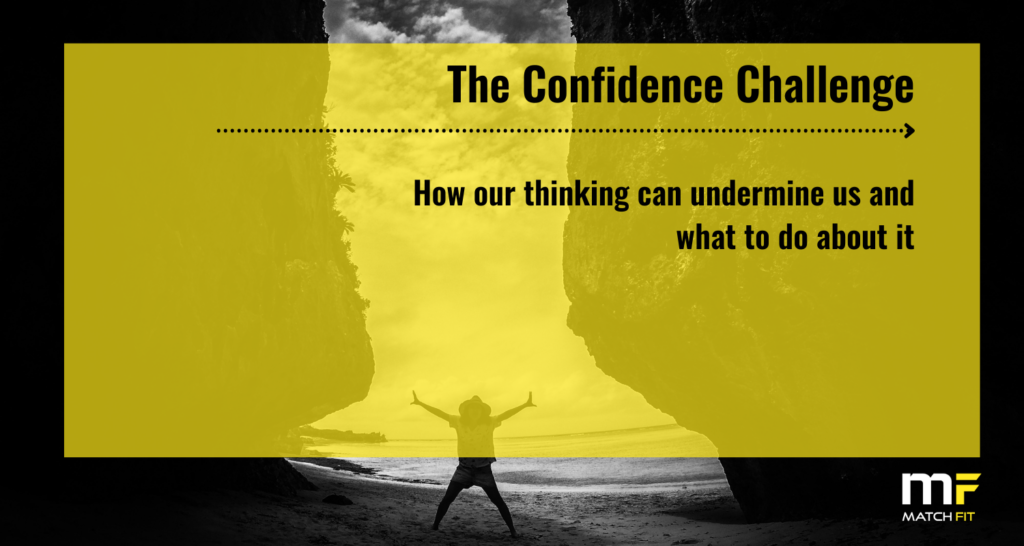Confidence can be a game changer, both personally and professionally. But is confidence innate or something we develop over time?
That’s an interesting question, but the truth is: it’s probably somewhere in the middle. Some people will definitely have ‘natural’ confidence and others will be ‘naturally’ shy. We can, however, build our confidence through hard work and persistence, so it becomes second nature.
However, most people aren’t taught how to be more confident, and have probably never asked. So they don’t consciously develop this characteristic and end up somewhere on a scale between very confident and very shy, or confident in some things, and not in others.
So overcoming the ‘Confidence Challenge’ is about first understanding that it is actually possible to overcome a lack of confidence. There are actions we can take to build our self-assurance so that it becomes a more natural behavioural characteristic.
Reduce ‘thinking errors’
Thinking errors can be key drivers of a lack of confidence. They are easy to nurture, but much more difficult to remove.
Many a scenario can be invaded by thinking errors, but presenting in front of a group of people usually puts them into overdrive!
Even if someone is articulate, senior, smart and presenting on something they know more about than anyone else in the room, if they lack confidence, thoughts such as  ‘I’m nervous about this’ or ‘What if I forget my words’ can easily creep in and undermine them. And if words such as ‘always’ and ‘every time’ start to manifest, the lack of confidence compounds.
‘I’m nervous about this’ or ‘What if I forget my words’ can easily creep in and undermine them. And if words such as ‘always’ and ‘every time’ start to manifest, the lack of confidence compounds.
At this point, the sympathetic nervous system triggers those familiar ‘flight or flee’ feelings: sweaty palms, shallow breathing, rapid heart rate. Together with thoughts such as “I’m going to mess this up” or “Oh my god, I can’t believe they’ve made me do this”. And this is not how we want to be walking into the boardroom ahead of a key presentation!
“I often ask people if those nervous feelings and thoughts are real,” says Bradley Honnor, managing director at MatchFit. “Or have they just told themselves those things for so long that they actually believe them? The latter is almost always true.”
So understanding that our thinking errors will undoubtedly be compounding a lack of personal confidence is a key first step.
Replacing our thinking errors
The second step is understanding what to do about your thinking errors.
This can be a complex process, but it usually helps to start by asking yourself questions like “What do I need to be thinking that would make me more confident?” or “What would a really confident person think in this situation?”
 You then need to develop the discipline to catch yourself thinking in a negative way and replace that thought every time. Replacing it over and over again until in the end you quite literally develop a new neurological pathway in the brain. And when that happens, those thinking errors will have been removed or dramatically reduced. New, more positive thoughts will occur automatically, which is a mentally healthier and more confident way of thinking.
You then need to develop the discipline to catch yourself thinking in a negative way and replace that thought every time. Replacing it over and over again until in the end you quite literally develop a new neurological pathway in the brain. And when that happens, those thinking errors will have been removed or dramatically reduced. New, more positive thoughts will occur automatically, which is a mentally healthier and more confident way of thinking.
“It’s really a process of identifying all the thinking errors and behaviours that aren’t helping your confidence, and then literally eradicating them systematically,” says Bradley.
And it’s a process that is proven to work, yet here we are with most people feeling that they’re just not confident, they’ve always been that way, it’s their nature, it’s their personality.
“If you are looking for that next jump in your career,” continues Bradley, “You can want it but not do anything about it, or even look at other people who have achieved it and think that they just have the natural ability to move more quickly up the ladder. Or, you can think: ‘I know what I need to do to get my next move’ and do it.
“And then it’s about goal setting and relentlessly trying to achieve your goal.
“In a way confidence and thinking errors seem obvious, but lots of people don’t know about it. They’ve never talked or asked about it. And I know that because when we talk about it in training sessions, people are always very engaged. We talk about the cognitive triangle; the link between thoughts, feelings, and behaviour. And whenever we do that, we can feel that people are engaged and saying to themselves ‘I do that all the time’”, Bradley says.
Identifying and eradicating thinking errors is a change that can we make over time that will have a dramatic effect on the paths our careers and personal lives take and, ultimately, our own experience of the world.
“And that, for most people, will be incredibly important,” concludes Bradley.

